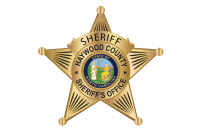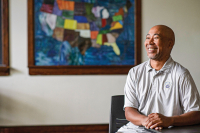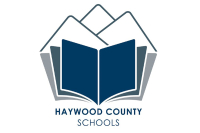Effort to revive language calls Cherokee old and young
Outside the annual Thanksgiving potluck dinner in the isolated Snowbird community, a remote corner of Graham County where the Cherokee language has deep roots, the parking lot is jammed full. It’s a dark night. The children play tag and the grown-ups stand in groups of two and three smoking.
Inside the brightly lit gym, hundreds of people sit at long folding tables to share turkey, traditional bean dishes, pies, sweet potatoes. There is a raffle drawing.
The food is eaten, the tables taken away, and Garfield Long Jr., tribal linguist for the Eastern Band of Cherokee Indians, sits with his granduncle Abel Catholster, watching young men play basketball.
Catholster, a tribal elder who doesn’t speak in English comfortably, is asked whether he thinks the Cherokee language will die. Long translates his answer.
“A long time ago a lot of the elders use to say this will become an English world. White. Like this,” Catholster said, nodding towards the gym.
“I think what he means is that everybody’s talking in English,” Long said.
Related Items
America’s first languages are dying. Across the country, indigenous communities are coming face to face with the reality that their fluent speakers are growing old and their younger generations are not only speaking but also thinking in English.
The Eastern Band of Cherokee Indians is confronting the challenge head-on with a tribally-funded language immersion academy where young children learn to speak Cherokee. But the people responsible for creating a new generation of Cherokee speakers in Western North Carolina are aware of a sobering fact –– there is no easy way to bring a language back to life.
In 2006, only about 300 people within the Qualla Boundary spoke Cherokee as their first language, and that number has grown smaller with each passing month.
The numbers point to one conclusion. The tribe needs to produce fluent speakers faster than it loses them.
Dr. Heidi Altman, an associate professor of linguistic anthropology at Georgia Southern University, acts as a consultant with the ECBI in their effort to develop a plan to revitalize the Cherokee language in their community. Altman said the Cherokee are not the only tribe facing the extinction of their language.
“It’s a complex thing. All the estimates from people are that certainly by the end of this century, there may not be any native languages spoken the way they used to be,” said Altman. “The lifespan of the language is only equivalent to the lifespan of the speakers. This is the critical moment. If it doesn’t happen now, it won’t happen.”
Renissa Walker –– director of the Kituwah Preservation and Education Program –– is part of a young group of tribal leaders in Principal Chief Michell Hicks’ administration charged with bringing back the language.
Walker didn’t learn to speak Cherokee as a child. For her, the effort is about preserving a distinct identity amid the American monoculture.
“The creator could have made you any type of person but he made you Cherokee,” Walker said. “We are aware of the value of the language, and we are aware that the language and the culture are in a fragile state.”
The spearhead of the tribe’s efforts is the new immersion language academy, which cost nearly $7 million and opened in September. The academy has 30 students between kindergarten and second grade and the goal is for them to be bilingual when they leave the school after fifth grade. The tribe also operates Cherokee language daycare for infants and toddlers.
While teaching the young people to speak is crucial to the survival of the Cherokee language, a parallel effort is under way, one that may ultimately prove more vital to preserving Cherokee thought patterns and ideals.
Walker’s mother, Myrtle Driver, is part of a group of elders on the reservation who speak Cherokee as their first language. Every month, the fluent speakers and tribal elders hold a gathering. These Cherokee Speakers Gatherings have brought the tribe’s older generation back to the fore of preserving culture and created a bridge that spans across generations and cultural experiences.
“When their heroes are Beyonce and Jay-Z, how can you say the culture is strong?” Walker said. “It’s competing with the society outside and it’s losing. If we held inside the values that our language holds we wouldn’t let the outside society affect us that way.”
For the first time in four decades some of the tribe’s fluent speakers are children, but they are too young to feel the gravity of what they are doing.
The importance of immersion
For 30 years the ECBI have undertaken various efforts to maintain the Cherokee language, but they have mostly amounted to not enough of a good thing. From mandatory high school classes that taught basic words and phrases to a variety of elementary pullout programs that offered grammar lessons, the students have been made aware of the cultural importance of the language, but they haven’t gotten any better at speaking it.
For Walker, that’s not good enough.
“Fluency to us means that you are a conversational speaker. The efforts have done a lot to preserve our heritage, but they haven’t really contributed to the number of fluent speakers on the reservation,” Walker said.
The pattern changed in 2005 with a $1 million grant from the Cherokee Preservation Foundation that allowed the tribe to take an inventory of its Cherokee speakers. After conducting a random sample survey of tribal members over the age of 10, the study showed that there were only 420 fluent speakers of the Cherokee language left in the Qualla Boundary, less than 7 percent of the local population.
Even more dire, less than 1 percent of that number represented adults of childbearing age.
Walker said the tribe ultimately used a word-of-mouth effort to find out if the study’s numbers were accurate. In the end, it was determined there were even fewer fluent speakers than first thought. In 2006 the number was closer to 300. Meanwhile the ECBI loses an average of three speakers per month and the average age of the speaking population is 53.
Walker said that trend is only getting more dramatic with time, threatening the preservation of not just the words of the Cherokee language but the thought patterns behind them.
“We’re going to see that number accelerate,” Walker said. “There’s features of the language that are being lost because the young speakers don’t use the language in the same way.”
Altman said the goal of the effort is to produce “stabile bilingualism” in the younger generation, something that has been achieved through similar efforts in New Zealand’s Maori community and in Hawaii. The ECBI, she said, are in a unique position because the tribe has taken ownership of the language preservation effort.
“The thing that works differently with the Cherokee is the language immersion program is a tribal program as opposed to a grassroots program, which brings its own benefits and its own challenges,” said Altman.
Gil Jackson, administrator at the Cherokee Language Academy, thinks the immersion program can change the paradigm.
“We’ve had these little ones since they were babies,” Jackson said. “We’re giving them two worlds at the same time and they’re getting it. We don’t just want to teach the language. We want to teach them to be Kituwah people as they once were.”
Teaching Cherokee in the immersion program is more difficult than simply speaking the language. Altman said efforts in other communities have been plagued by poorly trained teachers who will revert to English if a child becomes upset. The immersion teaching method is predicated on learners making the connection between a word and an idea in the same language.
“You have to really understand why it works and how it works, because the brain needs to be trained to learn the pathway,” Altman said.
According to Jackson, the young people who come through the immersion program and become fluent speakers will be able to expand their vocabularies as they get older, something second language learners in Walker’s generation can’t really do.
The distinction comes down to the way speakers acquire language, how they process information.
“If they’re a fluent speaker and their [Cherokee] vocabulary is limited, they’ll probably get it, but if they are a second language learner, probably not,” said Jackson.
Walker doesn’t want people to have any illusions about where the tribe stands with regards to its language.
“The effort to become conversationally fluent is significant,” Walker said. “People have a hard time with this, but there are parents out there who think their children are fluent and they’re not.”
And while the immersion program has come a long way since its inception in 2004, the children can’t grow up fast enough to replace the elder speakers who are dying.
“Immersion is only going to be good for so long, because we have a declining pool of speakers,” Walker said.
Walker credits her mother with coming up with a way to get the elders back involved in the discussion.
“She just said, ‘Wouldn’t it be a great idea just to get the fluent speakers together to visit,’” Walker said. “It grew from that.”
Gathering the elders
Native languages are disappearing across the country in part because government-sponsored boarding schools eradicated a generation of speakers.
Children who grew up in the 1940s and ‘50s were sent to “Indian” boarding schools where they were treated harshly and forbidden to speak their own language under the guiding philosophy that they had to assimilate into the dominant culture to survive.
The boarding school programs have been widely linked to post traumatic stress disorder and other emotional traumas that inhibited language retention even in children who spoke a native language first. But the particular history of the Kituwah, as the eastern Cherokee call themselves, lent itself to hanging on fiercely to their identity.
Walker’s mother, Myrtle Driver, grew up speaking Cherokee in the Big Cove community.
“That’s all that was spoken in my house because I was raised by my grandparents,” Driver said. “I was not allowed to speak English when I was home from school.”
Driver doesn’t remember being discouraged from speaking Cherokee during her elementary school years.
“We would talk Cherokee outside at recess and in the halls and no one ever punished us,” Driver said.
She attended schools in Cherokee and then went on to Haskell Indian School in Kansas, one of the most famous of the government-run boarding schools.
Driver said she never lost the desire to hang on to her language and culture.
“What I wanted to hold onto was my language and my traditions because that made me Kituwah,” Driver said. “Fortunately there were Oklahoma Cherokee there and I had a cousin there also and we spoke the same dialect.”
Driver spent more than 20 years away from Cherokee. When she came back, she got active in preserving the culture by teaching dancing to young people and by acting as an ambassador of Cherokee traditions.
She believes her greatest contribution to the preservation of Cherokee culture may have been the result of a casual conversation between her and Gil Jackson, administrator at the Cherokee Language Academy, which ultimately led to the creation of both the Cherokee Speakers Gatherings and the Cherokee Language Consortium.
“The idea [for the Speakers Gathering] just came in a conversation,” said Driver. “We ought to get the people together and feed them. It was probably the best thought Gil and I will have in our lifetimes. It just grew from there. That’s how the consortium came about.”
Driver and Jackson put out the word to fluent Cherokee speakers in the community and they began to gather together once a month over food to exchange stories and speak Cherokee.
According to Altman, the gatherings gave the language its social context back.
“A lot of the speakers had gotten to the point where they didn’t speak the language publicly anymore,” Altman said. “Once it’s only spoken in the home and there’s no socially viable way to speak it, a language is really on its way out.”
Jackson said the gatherings helped people remember old words that had disappeared.
“What happens at the speakers gathering often times someone will come in with an old word that we may have forgotten and that’s what happens when you bring in strong speakers,” Jackson said.
As the gatherings grew, they became a vehicle for the elders to talk about their culture, but they also served a practical purpose.
When one word tells a story
The language academy often works with children’s books that have been written in English. Translating them into Cherokee is tricky, particularly with modern words.
The speakers gathering became an impromptu method for translating.
“Television box –– there is no Cherokee word,” Driver said. “What is the best way to describe it? It makes things appear. If you know how it works or what it is then you can think about it in Cherokee and you’ve got your word.”
According to Jackson, older Cherokee speakers often have one word for something that younger speakers have to explain in a roundabout way. For instance, there is a single word in Cherokee to say ‘My feet are cold.’
“The old speakers don’t have to describe it, they have a word,” Jackson said.
The Speakers Gatherings now draw around 30 people each month, and they have outgrown the expectations of their organizers.
“The beauty of it is these words will make us think of a story and we’ll share that story,” Driver said. “There’s not only two lessons then, there’s three lessons because of the tradition in the story. We’re not just preserving the language, we’re preserving the traditions.”
Another benefit of the Speakers Gatherings has been the creation of a forum for discussion about where the language has come from and where it is going.
To that end, the organizers began inviting outside speakers to come in and talk about efforts to revive native languages in other communities.
One of the earliest speakers came from Oklahoma Cherokee country. Altman said the event created a connection with a lasting impact.
“Part of what’s happened is there were sort of parallel tracks going on between the people in Oklahoma and the Eastern Band,” Altman said. “It was interesting because some of the people were of the impression that the dialects were far apart but once they came together, they realized they weren’t.”
The increased dialogue between the Oklahoma Cherokee population and members of the ECBI, led to the creation of the Cherokee Language Consortium, a semi-formalized language workshop that takes place twice a year and includes native speakers from the ECBI, the United Cherokee Tribe, and the United Keetoowah Band of Cherokee.
Altman said that Tom Belt, an Oklahoman who teaches Cherokee at Western Carolina University, has been a bridge between the two groups.
The consortium works on creating Cherokee words for English words like cell phone, plastic, CD, and computer, which translates as “electric brain.”
While the translations have a practical goal–– to arm the younger generation with the words they need–– they are also the front line of the confrontation between English and Cherokee cultural thought patterns.
Half empty or half full?
For Cherokee speakers of Abel Catholster’s generation –– men and women who grew up with a totally Cherokee worldview –– the loss of the language is a bitter pill to swallow, and it is more or less something that has already happened.
Catholster was raised in the Wolf Creek community above Blue Wing in the late 1920s. He says he is 84.
“He may be older than that, cause we’re not really sure when he was born,” said Garfield Long, his grandnephew and the ECBI’s linguist.
According to Long, Catholster was repeatedly rounded up and brought down the mountain to attend school only to escape at his earliest convenience. He later worked as a laborer to build the road over Newfound Gap in the Smoky Mountain National Park.
Catholster grew up geographically and culturally isolated, and as a result his world was 100 percent Cherokee. These days, Cherokee children grow up in an English-speaking world and the evolution of media has meant that in most cases Beyonce and Jay-Z are as accessible to them as their grandparents.
Long believes the new generation of speakers needs the elders to help them learn the meaning behind what they say, and he’s not sure if there’s time enough to make it happen.
“As far as language goes we have a chance of survival but I feel it’s going to be limited because the speakers we do have around may not be willing to share,” Long said.
Long doesn’t believe the culture can survive without the language.
“Personally I think you have to have the language. It doesn’t matter what tribe you’re from,” Long said. “You can tell me you’re Cherokee and you are, but if you don’t know the language you don’t know what makes us unique.”
If there is a hope, Long believes it lies in harnessing the energy of the elders.
“I think as far as the speakers go it helps maintain the bond we have because we all have something in common, we’re striving for the same result,” Long said. “It was only when the speakers gathering got started that some of the older speakers realized it was important to preserve the language.”
For Long, the knowledge of the elders is something that transcends language, and even in his own family he has felt the loss.
“They share some things that would almost be considered mythology in our context but to us they are real,” Long said. “At our family functions now, the non-speakers outnumber the Cherokee speakers.”
In contrast to Catholster and Long, who have seen the declining strength of the language over their lifetimes, Altman has witnessed the growth of the preservation effort as an outsider. Viewing the Eastern Cherokee’s situation in the context of similar movements around the country, she is encouraged by how far things have come.
“When I first came up there about 10 years ago you almost never heard the language in public and there wasn’t a lot of faith that something good would happen,” Altman said.
The preservation effort has had the collateral benefit of bringing a new group of actors into the effort –– people Altman says have “passive competence.”
“They’re coming out for sure. Ten years ago this never would have happened,” said Altman. “Now there are little kids who are speaking the language and that has served as a catalyst.”
Altman believes the community may have more resources than it knows, because people continue to step forward to offer help.
“Seeing the positive energy around this has drawn a lot of people out. You can look at the sad part of it, but there are a lot of people coming out of the woodwork who have skills we didn’t know they had,” said Altman.
The real challenge facing the Eastern Cherokee is how to get the elder speakers and their newest fluent speakers together in such a way that the people in the middle also begin to learn the language.
“One of the things we’re really trying to do is get the kids around the older speakers as much as possible so they are learning those thought patterns,” Altman said. “You can learn Cherokee as a second language learner, but it’s very hard and it takes a lot not to be translating back and forth in your head.”
The task is a dizzying one for Walker, who is still coming to grips with the fact that her generation didn’t learn to speak when they were kids.
“Is it that we weren’t paying attention?” Walker said. “Is it that we were taking it for granted? Did anybody think about the language at that time?”
Her mother, though, has her eyes on the future.
“Today we are not in danger of losing our language,” Driver said. “It used to be the burden was put on the shoulders of the speakers. Not anymore. The burden is on the shoulders of the little ones.”









